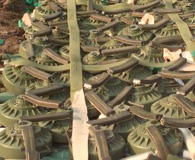Tactics 101: 026. Cordon and Search Operations
Phase 5: Conduct Search – Obviously, the decisive phase of the operation is the execution of the search. The unit must clear the area, search for the targets (personnel or material), and then conduct consolidation and reorganization. As stated before, a unit will likely find itself augmented by various "specialists" to conduct the search. These professionals bring valuable expertise to the operation; however, in many cases they may have limited experience working with the unit they are attached to. This can be a test for any commander.
Phase 6: Withdraw from Objective – You maneuvered to the search area, conducted the search and now it is time to leave the AO (Area of Operations). As in most operations, this is usually the most challenging phase of the mission. The principles for withdrawing from the search area are similar to a withdrawal in any environment. Key in the withdrawal phase is proper determination of withdrawal routes. If at all possible never use the same routes leaving as you did coming in. The chances are they will be far more dangerous this time around.
{default}Phase 7: Conduct After-Action Review – Although somewhat overlooked, this is one of the most important phases of he operation. After the mission is complete, you must conduct a thorough analysis. What went right? What did not go so well? What are the lessons learned we can carry over to the next operation? These are all vital questions that must be answered.
 KEYS TO SUCCESS
KEYS TO SUCCESS
Every mission has certain elements that will assist in mission accomplishment. Let’s briefly address those for cordon and search.
- Surprise – Obviously, you do not want to tip your hand as about your operation. Surprise ensures your enemy cannot react prematurely. This reaction could mean some type of spoiling attack or hiding the material or person you were looking for.
- Speed – Once the operation begins, speed is critical. Of course, as we discussed before, it must be controlled speed. Again, the famous basketball coach John Wooden said, "hurried, but not rushed!"
- Isolate – As in all urban operations, isolation is vital. You must isolate the target area. That is the cordon of cordon and search. You must ensure the target cannot escape or receive assistance from outside sources.
- Positive Target ID – There is much activity going on in an urban environment and in all likelihood your target area is filled with civilians. This makes finding your target difficult even with the best intelligence. Make a mistake in target identification, and you could initiate a public relations nightmare.
- We are in this Together – In many situations (such as today), you could be conducting operations in support of a host nation government; thus, your operations must reflect this. If they do not, the country is likely to spin into more chaos than it is currently in.
- Damage Control – When conducting a cordon and search operation you must keep collateral damage at a minimum. There is no better way to turn a populace against you than to destroy their homes and businesses. It is also a good way to dry up potential or current intelligence sources.
- Act on Actionable Intelligence — In most cases, you have a limited time to conduct an operation; reliable intelligence ages quickly. If you let the window close, you may not see it again. Of course, do not act on highly questionable reports from questionable sources; putting Soldiers’ lives on the line for no good reason is not a good way to lead a unit.
- C3 (Command, Control, Chaos) – Commanding a unit conducting a cordon and search is a supreme challenge. As a commander you have elements maneuvering in a relatively small area. These elements are often intermixed with civilians and enemy acting as civilians. A commander must know where his Soldiers are. He must also provide an environment where initiative is encouraged. The micro-manager will not succeed in this operation.
SUMMARY
The cordon and search is one of the most universal types of tactical operations conducted in the war on terror. By understanding how the forces are organized for this unique but common operation, one can appreciate the challenges. Whether at the company or battalion level, cordon and search requires detailed planning and creative thinking. It’s truly a thinking man’s game!
NEXT ARTICLE
In next month’s article, we will move away from our urban operations theme. Our focus will be on discussing the concept of commander’s intent. Within this area, we will key on the importance of intent and its evolution within the U.S. Army, and we’ll provide some interesting examples from commanders in the past.


This was an outstanding help to my classes on CS. Thanks for publishing this peice.